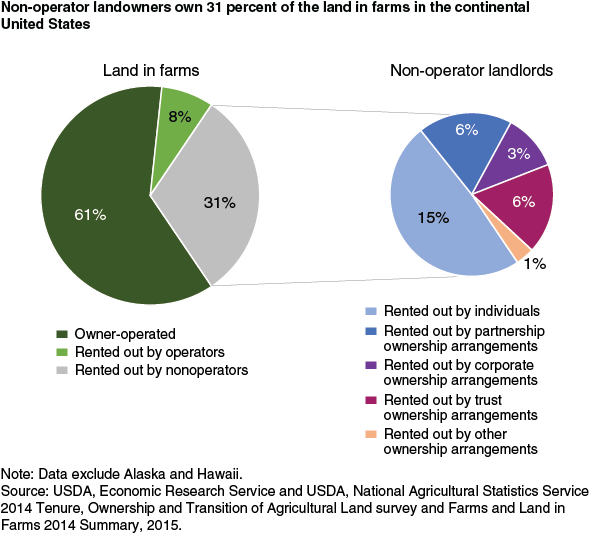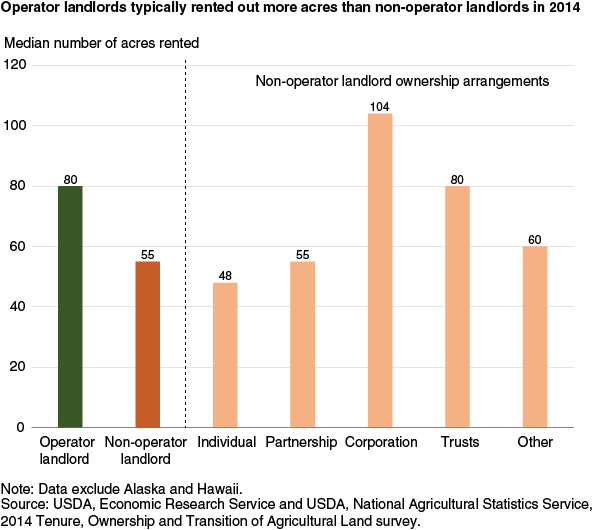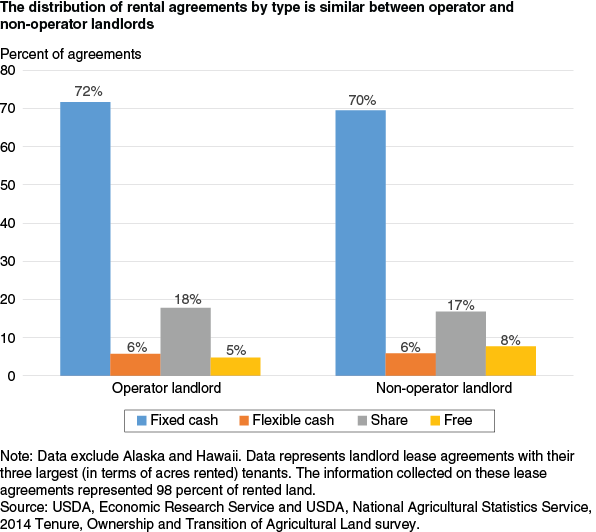Tenure, Ownership and Transition of Agricultural Land (TOTAL) Survey 2014: A New USDA, Economic Research Service/National Agricultural Statistics Service Data Product
- by Allison Borchers
- 11/2/2015
Of the 911 million acres of land in farms in the contiguous 48 States, 61 percent (557 million acres) is operated by the land owner, according to the 2014 Tenure, Ownership and Transition of Agricultural Land (TOTAL) survey. Another 8 percent (70 million acres) is rented from other farm operators (referred to as “operator landlords”). The remainder of land in farms (31 percent, or 283 million acres) is rented from “non-operator landlords” or landlord entities that are not currently farm operators.
The TOTAL survey is a new national survey jointly sponsored by USDA's Economic Research Service and USDA’s National Agricultural Statistics Service. The survey provides current information on a variety of topics related to farmland, including ownership, income, expenses, debt, assets, and demographic characteristics of non-operator landlords, as well as information specific to land such as the acquisition and transfer of land, sale and leasing of gas and oil rights, and rental agreements. TOTAL is representative of all agricultural land, held by both operator and non-operator landowners, in the contiguous 48 States.
Because farm real estate is so important to the farm sector—it was valued at $2.38 trillion in 2014, and accounted for 80 percent of the value of farm sector assets—the ownership of agricultural land is of interest to many, including farmers, policy makers, and lenders. Also, due to its large contribution to the value of assets, changes in farm real estate values are a critical barometer of the farm sector's financial performance. The changes in value affect not just farmers, but non-farmers who own agricultural land. TOTAL offers a snapshot of who owns agricultural land, providing insight into how much of farm sector equity accrues to farmers and non-farmers. TOTAL also helps inform on issues surrounding farm succession, access to land for beginning farmers, production, conservation and easement decisions that require long-term investments, leasing arrangements, and farm structure.
USDA surveys typically focus on farm operations, however little is known about the landowners (landlords) of the 39 percent of land in farms that is rented. Data from the TOTAL survey helps fill this gap with the additional information it reveals about agricultural land owners (landlords) who rent out land to farm operators, particularly non-operator landlords. The 354 million acres of rented land in the lower 48 States in 2014 were rented out by 2.13 million landlords. Non-operator landlords comprised 87 percent of these landlord entities, while the remaining 13 percent were operator landlords. Of the rented acres held by non-operator landlords, the majority of acres are held by individuals (138 million acres) or partnerships (53 million acres). Corporate arrangements control 11 percent (32 million acres) of non-operator landlord acres. The remainder of non-operator landlord acres are held in trusts (50 million acres) or other ownership arrangements (11 million acres).
The amount of land rented out per landlord entity yields insights into whether rented farmland is concentrated amongst particular types of landlords. Operator landlords—farm operators who rent land to other farmers—typically rent out more acreage than non-operator landlords—a median of 80 acres compared to 55 acres. However, the majority of rented land is held by non-operator landlords and is typically held in smaller sized holdings. Among non-operator landlords, the acres held in corporate, trust, and other types of non-operator ownership arrangements are more concentrated (proportionately more land in fewer hands) than individual and partnership non-operator landlords. Non-operator corporate ownership arrangements, on average, have the largest holdings at 104 acres. However, this entity type owns only a small portion, 9 percent, of rented land (3 percent of all land in farms).
Concentration of ownership may be suggestive of the time and effort it takes when farm operators seek to rent additional land. The median rented acreage for farmers who rent land from others was 111 acres in 2014—larger than the median acreage rented to farmers by each landlord type. This means that most farm operators looking to rent farmland must instead piece together holdings from multiple landlords.
The nature of lease agreements between landowners and the operators have implications for several farm operation decisions, including production, conservation, and access to land through renting. The TOTAL survey asked landlords detailed questions about the lease agreements with their three largest (in terms of acres rented) tenants. Only 1 percent of all landlords had more than three tenants. The information collected on these lease agreements represented 98 percent of rented land.
These data allow researchers to examine leasing patterns and whether lease agreements differ between types of landlords. There are four basic types of leases, including: fixed cash rent payments, flexible or hybrid cash rent payment (for example, due to fluctuating markets all or part of the payment is determined based on prices after the crop is harvested), a share of production and expenses, or free-of-charge. Over 70 percent of leases used a fixed cash rent payment. There are few differences between the distribution of lease agreement types between operator and non-operator landlords. Non-operator landlords had a slightly larger share of free-of-charge agreements. Non-operator landlords are more likely to have written agreements with their tenants (41 percent of agreements compared to 39 percent). More than a third of non-operator landlord-tenant relationships have spanned longer than ten years (compared with under 25 percent for operator landlords). Additional research could examine whether lease structure varies by ownership arrangement, and landlord characteristics including their location relative to the land rented, and prior farming experience. This information can help inform program outreach efforts, as non-operator landowners who previously farmed or who live close to the land are more likely than absentee landlords to be familiar with USDA programs, including beginning farmer, risk management, and land conservation programs.
This article is drawn from:
- Land Use, Land Value & Tenure - Farmland Ownership and Tenure. (n.d.). U.S. Department of Agriculture, Economic Research Service.




